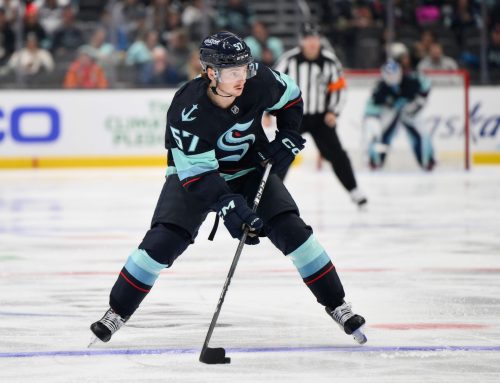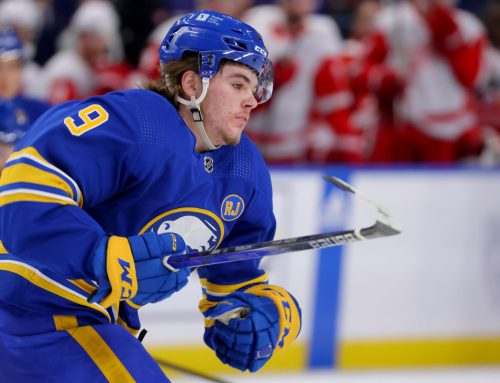The Journey: Projecting Sample Sizes
Brayden Olafson
2019-09-07

Last week I hopped on the Dobber Prospects Radio show with Peter Harling to discuss various topics in the prospect world including the Dobber Prospects Fantasy Hockey League, the QMJHL, and the New York Rangers. In our discussion we touched on the future of one Ivan Chekhovich – a San Jose prospect who tallied 105 points in his final year playing with the Baie-Comeau Drakkar.
All things considered, Peter and I concluded that based on his performance in the Canadian Major Junior system, Chekhovich was likely to spend much of the next three years continuing to develop his game in the AHL, despite his outstanding point totals last year. Two factors however, brought hesitation to our conclusion – first, the Sharks pipeline is relatively shallow these days, outside of the apparent OHL’s least wanted defenseman Ryan Merkley, Chekovich might actually have the greatest NHL ceiling of what we would consider prospects. Secondly, after being eliminated from the QMJHL postseason, the Russian joined San Jose’s AHL farm club (the Barracuda) and had a great amount of success through the final five regular season contests and even into more meaningful games in the AHL playoffs.
Which brings us to the question, and the main topic of today’s edition of The Journey. Our evidence in projecting Chekhovich as a player at the next level seems to be conflicting. On one hand, he’s a seventh-round pick who to me didn’t stand out like I thought he would have at the major junior level. On the other hand, he did manage to score over 100 points (as a 20-year-old), and truly make an impact in what I would consider to be a meaningful debut stint at the second-tier level in North America.
Chekhovich’s year-end in the AHL is truly what is most interesting about this whole scenario, and often something that fantasy owners will look for around draft time, even if it’s a small sample size. For myself in particular, these types of players become extremely interesting for one of my fantasy league’s format, which drafts all players who were not previously drafted into the league. When it becomes even more interesting, however, is when that same success is seen in a small sample size at the NHL level – then what conclusions can we draw?
The group of players who either entered the league late, or had a quick mid-year audition in the NHL is a far more interesting group than what I would pool Chekhovich with. That list includes the following list of rookies who had the most offensive success in a period of between 5 and 20 NHL games last year.
Taro Hirose, Detroit Red Wings – 10 games
Max Comtois, Anaheim Ducks – 10 games
Victor Olofsson, Buffalo Sabres – 6 games
Quinn Hughes, Vancouver Canucks – 5 games
Karson Kuhlman, Boston Bruins – 11 games
Drake Batherson, Ottawa Senators – 20 games
Nathan Bastian, New Jersey Devils – 7 games
Carl Grundstrom, Los Angeles Kings – 15 games
Caleb Jones, Edmonton Oilers – 17 games
Filip Zadina, Detroit Red Wings – 9 games
My favorite place to start with this kind of thing is in the history. The year prior, the list of players matching the same criteria is as follows:
Casey Mittelstadt, Buffalo Sabres – 6 games
Ryan Donato, Boston Bruins – 12 games
Valentin Zykov, Carolina Hurricanes – 10 games
Ty Rattie, Edmonton Oilers – 14 games
Anthony Cirelli, Tampa Bay Lightning – 18 games
Dylan Sikura, Chicago Blackhawks – 5 games
Joe Hicketts, Detroit Red Wings – 5 games
Austin Czarnik, Boston Bruins – 10 games
Tanner Kero, Chicago Blackhawks – 8 games
Daniel Sprong, Pittsburgh Penguins – 8 games
Now depending on how you look at that list, it could paint a relatively bleak image for this year’s class. Casey Mittelstadt who led the class with a 68-point pace through a mere six NHL contests. After being drafted with a conservative 40+ point projection, he followed it up with a bust-worthy 25 points through 77 games with the Sabres.
Making things look even worse for the class was the third-ranked player, Valentin Zykov. The then 23-year-old Russian posted an entertaining seven points through ten NHL games, only to be quickly shipped out of Carolina after a horrendous start to the following season. His fortunes in Edmonton or Las Vegas were none the more impressive, concluding the year with a combined 15-point pace.
The only respectable fortune, in fact, to come of the 2017-18 top-10 class was that of fifth ranking Anthony Cirelli. At 21 years of age, Cirelli had gradually developed his game into one that suited the NHL well. He proved it over the course of an 18-game audition in Tampa where he averaged just over 13 minutes of time on ice per game. His realistic 50-point pace in that slightly more generous sample size was exactly what made him a safe bet for the following year. He proceeded to work his way up, albeit modestly, into the Tampa lineup, earning an extra minute of average ice time and nearly capping the 20-goal plateau.
There are some players of the group who we could argue did not receive a fair shake in the year that followed their impressive debut. Ryan Donato’s ice time was cut on average by a minute in the year that followed his 12-game breakout. He was also taken off of a line with David Krejci, in favor of a rotation that included Anders Bjork, David Backes and essentially the Bruins’ entire bottom-6 core. He was cast as a shutdown forward, when truly, he was worthy of much more. In an interesting complement, Austin Czarnik, who had seen success in that role with the Bruins, was juggled through the Flames’ lineup at a significantly reduced rate than he would have been used to in Boston, and just as importantly, Providence.
So where does that leave us with the current crop of players who are entrusted with following up their impressive stints in the NHL? First off, I would judge each player by his individual merit. While Quinn Hughes had an absurdly small sample size to justify his 49-point pace, the Canucks entrusted a seventh-overall selection to the eldest of the brothers and are sure to be gentle with his deployment to open the season. They’ve all but confirmed his place in the team’s lineup for the upcoming season and he should be expected to start with a relatively sheltered role in order to build his confidence at the NHL level – he should have no trouble making a respectable stab at his projections.
Victor Olofsson, however, is a player where sample size should probably raise a few eyebrows. The Buffalo prospect doesn’t look to be locked into the Sabres’ lineup as we approach the NHL pre-season. His AHL debut was outstanding, but it’s likely that he’s due to put in some more time before being offered a similar opportunity to last year where he was blessed with the linemates of Sam Reinhart and Jack Eichel.
Taro Hirose’s success seems to be extremely projectable, despite a mere 10-game audition. His primary linemate during that time was Andreas Athanasiou, who received an apparent boost while playing alongside Hirose himself. While his rate of 57 points might be lofty, a comparable opportunity should lead to short- and long-term success for the Michigan alumni.
Karson Kuhlman could truly be the second coming of Austin Czarnik in Boston. He looks to have had a moderate amount of success playing in the Bruins middle-six, however, with some dependence on the offensive crutch of Jake Debrusk. His 37-point pace from last season is more likely to fall in the range of 25-30 points, in my opinion.
The most exciting player from last year’s list in my opinion, however, is Caleb Jones. The Edmonton blueliner entertained for a slightly healthier sample size than the rest of the group and truly drove the offense during his opportunity. Edmonton offered the 22-year-old ample ice-time alongside questionable pairings Kevin Gravel and Adam Larsson. His power-play deployment was minimal, yet the American consistently created offense at a repeatable rate. His 28-point pace should be easily repeatable, and I wouldn't be surprised to see more if Hitch finds the youngster some extra time on the Oilers’ powerplay.
Sadly, if I had to pick a bust from this list it would be Carl Grundstrom. As excited as I was to see the former Leaf produce once he had an opportunity to in Los Angeles, his near 20% shooting rate, combined with linemates of Tyler Toffoli, Jeff Carter and Adrian Kempe are unlikely to be repeatable factors in the year ahead. While his future may gradually become more fantasy relevant, I certainly wouldn't bet my last dollar on him continuing at a rate of 33 points – at least not immediately.
***
I sincerely hope you’ve enjoyed reading what I would consider the first edition of this hockey season’s The Journey. I hope you’ll be back for more as we make our way into another exciting fantasy season.
Catch me on Twitter @olaf1393





 CAR
CAR NYI
NYI BOS
BOS TOR
TOR VAN
VAN MTL
MTL EDM
EDM WPG
WPG CGY
CGY
